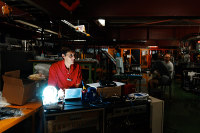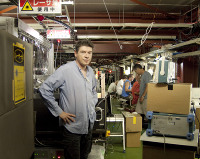 |
 |
|||||||||||||
|
|||||||||||||
|
|||||||||||||
|
On 27 September, the Japan's local winners of the first Global Particle Photo Walk were announced. This Photowalk was held at five particle physics laboratories in the world on 7 August (see Feature Story this week). The winning photo taken by Yuki Hayashi features scientists working at the Accelerator Test Facility (ATF) at KEK. But they are not Japanese scientists. They are three of the nine French scientists and engineers who were visiting the ATF from the end of July to install and test their four-mirror optical cavity. This R&D on the four-mirror cavity is aimed to produce intense polarised positrons – one of the most important and challenging technologies for the ILC. Parallel to the ILC reference design, which adopts helical undulator-based positron source (see Image of the Week), scientists are working on the R&D for the laser Compton positron source. “It was a conceptual design five years ago,” said Fabian Zomer from LAL (IN2P3/CNRS) in Orsay, France. The international team submitted the conceptual design to the very first ILC meeting held at Snowmass, US in 2005. “People thought the laser Compton scheme was almost impossible at the time,” Zomer said. With this scheme, a pulsed-laser beam is sent onto electron bunches, so that they emit powerful gamma rays which convert into pairs of polarised electrons and positrons on a tungsten target. Now, they came to the point to install their cavity system at the ATF beamline, and test it with real beams. “I was really worried about moving elements of the four-mirror cavities into the ATF tunnel. I am relieved now that everything turned out fine,” said Tsunehiko Omori, a KEK scientist working on the R&D of the ILC positron source together with the French team. ATF is surrounded by big concrete blocks stacked on top of each other. “To move a large experimental apparatus into the dumping ring tunnel, we needed to make an entry way by dislodging the concrete blocks of the ceiling,” said Omori. ATF is always maintained, neat and clean but pretty much crowded with all the cables and magnets. Plus, it was built at the space originally used as an assembling hall for the TRISTAN accelerator, and not exclusively designed for ATF dumping ring. “We only got a triangular space about the size of three metres by three metres as a doorway,” Omori said. “Each element is very fragile, so we needed to be extremely careful,” said Zomer. It took three days for them to move all elements. Then they put them together, and successfully passed the safety inspection on 17 August. “All team members are working very, very hard”, said Zomer “The ATF summer shut-down period is the only opportunity we have, and we need to finish all our jobs during this period. If we missed this summer, we would have to wait another one year.” This is why the French physicists were the only scientists in the photos of the photowalk – it happened on a Saturday! They are now working on synchronising the whole cavity system with the ATF radiofrequency system, which stores the electron beam in the damping ring. The test runs with real ATF electron beam is scheduled to be carried out after the ATF restart in mid October. -- Rika Takahashi |
|||||||||||||
| © International Linear Collider |

